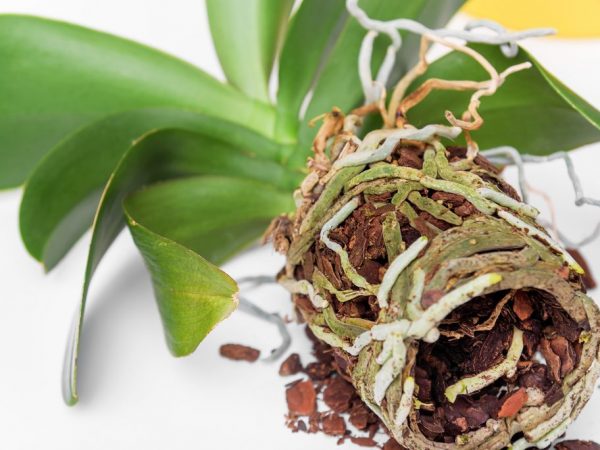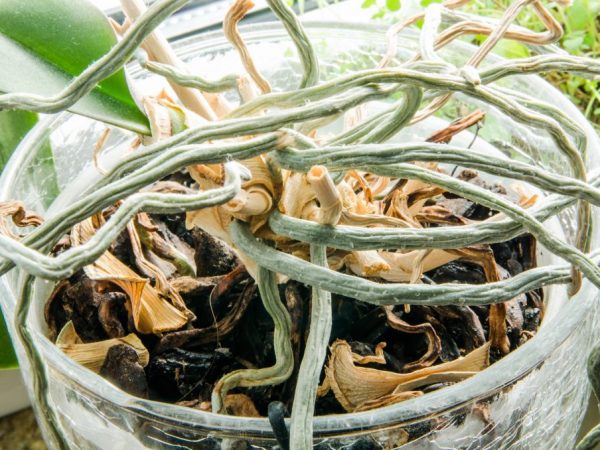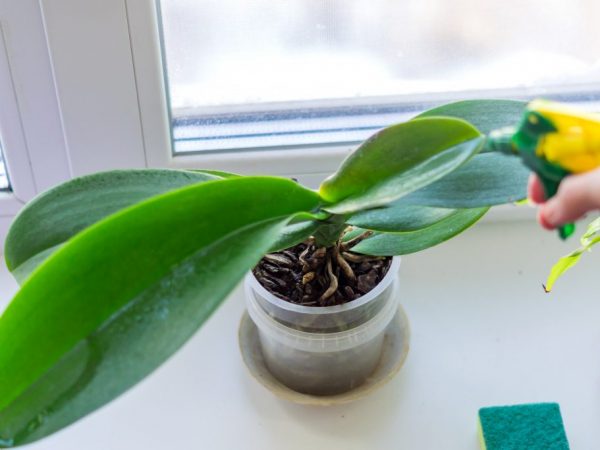Extension of roots in an orchid
Orchids often lose their roots due to improper care. They dry out or suffer from rot. Growing roots in an orchid is a lengthy process. And the earlier the treatment is started, the more efficiently and faster it will be possible to return the plant to its health and beauty.

Extension of roots in an orchid
Causes of orchid root problems
Phalaenopsis grows in the wild in the tropics. The exotic flower is used to high humidity and temperature. Therefore, when growing orchids at home, problems often arise. Errors in the organization of watering, temperature and humidity, substrate air permeability and fertilization can lead to problems with the roots of the flower.
If you continue to care for the flower incorrectly, it can lose its healthy appearance. At first, the leaves look lethargic or dry out, there is no flowering, and with further inactivity, the orchid dies. Diseases and pests are also the cause of the pathological state of the root system.
Flower resuscitation
You can save a flower that has lost most of its roots due to florist's mistakes by providing the plant with first aid. Rinse the roots under running warm water, remove the damaged roots with a clean, sharp blade (it also needs to be disinfected) and treat the wounds with activated charcoal or cinnamon.
With a slight damage to the roots, you will need to transplant the pet into a new substrate. But, if more than 90% of the roots were destroyed, the flower will be reanimated. There are such ways to restore the Orchid root system:
- growing root shoots in the greenhouse;
- rooting in moss;
- rooting in tree bark;
- water treatment.
Each method has its own advantages and disadvantages. The most risky option is the water treatment option. Safer, but long-term options are rooting in moss and bark.
Growing roots in the greenhouse
This method has many advantages. The equipment of a greenhouse for keeping a sick orchid will allow the growth of root shoots in 1 month. But to get such a result, you have to take certain measures. The plant owner must:
- Prepare an airtight container - a glass jar or a cut bottle.
- Put expanded clay at the base of the greenhouse, which is a drainage layer.
- Put sphagnum moss as the second layer.
- Place the damaged orchid so that its base touches the surface of the soil.
- Cover the greenhouse with glass or polyethylene.
After equipping the greenhouse, the container is placed in a well-lit place. The positive effect is achieved by maintaining the temperature and humidity levels in the greenhouse. If necessary, the container is immersed in warm water up to 3 times a day for 5-10 minutes.
Resuscitation in sphagnum moss
It will also be possible to restore the root system of the pet with the help of a light soil used for growing Orchids - sphagnum moss. Apply it after preliminary disinfection or steaming. We save the flower like this:
- Fill the drainage layer at the bottom of the plastic container.
- Tamp down a layer of moss.
- Install the damaged pet so that the point of the growth zone remains open (it is possible to install supports for the stability of the pet).
- Spray the surface of the soil with a spray bottle.
This method is suitable for those growers who find it difficult to control the moisture content of the substrate. Its only drawback is the rooting time. They prepare for a flower transplant no earlier than 6 months later.
Resuscitation of a plant in water

It is very difficult to revive a plant in water.
Resuscitation of an orchid without roots should be based on the conditions for stimulating the dormant bud to germination or on stimulating the root formation of the growing point. If orchid babies appear, it will be easier to reanimate and plant a flower. Good performance in the treatment of the root system is shown by the content in water.
It will also be possible to save the flower from death when the flower is immersed in water. This method is effective if the cause of damage to the root system is not waterlogging of the soil (repeated immersion in the liquid often provokes the development of a pathological process, so the plant will not survive). Perform this procedure step by step:
- Warm settled water is poured into the container.
- The base of the flower is immersed in liquid.
- Place a vessel with a flower in a well-lit place.
- If necessary, add water (once every 7 days, the water will have to be completely replaced).
It is difficult to restore the roots of a pet in this way. We'll have to monitor the condition of the flower and, in the event of the death of its tissues, determine it in a timely manner.
Another version of the water procedure is with the leaves down. The flower should be planted in a cut plastic bottle with the leaves gathered in a bunch down. It is required to crush activated carbon, take wood ash and mix with water. The resulting liquid is poured to the middle of the container, so that the living root outgrowths remain in the air. Moisture, evaporating, will go out into the growth zone of the flower, which will stimulate it to root formation. Spray the aerial roots with a spray bottle periodically.
Air baths
When water treatment is unsuccessful, air baths can help the roots grow back. Among gardeners, this method is known as root drying.
It will turn out to revive the indoor flower by alternating water and air procedures. During the day, the flower is kept in a container with liquid, slightly dipping the base of the pet into it. At night it is placed above the vessel. This procedure is repeated daily until root problems disappear. When signs of rooting are noticed, planting in light, nutritious soil is necessary.
Tree bark treatment
This method is effective when there is a flower growth point. Reanimation of the pet takes place according to the rules of Orchid grafting. It will be possible to root the pet if the growth point is in contact with the ground. The only difference is that the peduncle does not need to be cut into the dormant buds.
When using the bark method at home, rooting occurs in just a few weeks. We save the flower like this:
- Pour the bark treated with fungicides into a plastic container.
- Remove all damaged parts of the root system. Only healthy tissue is important to preserve.
- Tie the leaves with cut strips of elastic tissue to the base of the container so that the growth zone of Phalaenopsis is in contact with the bark.
- Spray the bark with a spray bottle.
Resuscitation of the base of a flower with leaves is carried out in 3-4 weeks. The main thing is to follow the indicators of temperature and humidity in the room. The temperature should be at least 24 ° C, and the humidity should be 50%.If necessary, a container with water is placed next to the pot.
The use of drugs

Spraying with phytosporin stimulates the growth of the root system
It is also possible to cure the roots from fungal infections or signs of other damage with the help of specialized means. After removing the damaged roots, as well as treating the cut sites with antiseptics, stimulate the growth of the remaining healthy root system. There are many such drugs. The most popular are:
- Kornevin. The proportion of the preparation of a solution of 3 g of the substance per 6 liters of water. The flower pot is immersed in the prepared solution.
- Succinic acid. Dilute the solution in a ratio of 1 tablet to 250 ml of water. It is used for soaking damaged root systems and for spraying peduncles and leaves.
- Fitosporin. Diluted in equal proportions. Use a solution to spray the leaves and soil.
Glucose is useful for growing the root system. By rubbing the leaves, you will help the flower get the strength it needs to grow a weak root system.
Rescue a flower without roots
It is also possible to save an orchid without roots. There is hope of salvation only when the grower acts immediately and according to a certain algorithm. If only one stem remains from the pet, it is resuscitated in water. Before immersing the flower in warm, settled water, trim the damaged tissue, and treat open wounds with antiseptic agents.
After immersing the remaining stem with leaves in warm water, place the container in a well-lit place. It is best to avoid direct sunlight. As the liquid level evaporates, it is topped up. Complement the care of an orchid that has lost all roots, rubbing the leaves with a solution of succinic acid, prepared in a proportion of 1 tablet per 250 ml of water. In order to avoid hypothermia of the pet, when the air temperature drops at night, the container is covered with plastic wrap or it can be done using a regular bag.
Under properly created conditions, the flower rarely dies. After 2-4 weeks, growing the roots brings the first results - new young roots appear. When the orchid has given several such shoots, it will have to be cut off, leaving the baby and transplanted into a pot. The best soil for further rehabilitation is sphagnum moss. It absorbs moisture well, is breathable and rarely becomes infected with various infections.
Preventive measures
Having decided to grow Phalaenopsis at home, it is important to take into account all the subtleties of caring for it. In general, Orchids are capricious plants. But with proper care, they will grow and develop well, delighting their owner with abundant flowering.
Such indoor flowers do not respond well to any deviations from comfortable conditions of detention. And the roots are the first to suffer from this. To avoid problems with rotting or drying of the roots, we grow an orchid correctly:
- It is necessary to organize a comfortable microclimate for the flower. The air temperature should not fall below 15 ° С in winter and 21 ° С in summer. Favorable humidity level 50-60%.
- Organize a high-quality watering regime. Monitoring the condition of the soil will help to avoid problems with drying out and waterlogging of the substrate. Water the plant when it looks dry. Another option is to immerse the flower pot in warm water for 20-30 minutes.
- It is important to shade the flower from direct sunlight and protect it from the heat of heating devices in winter. The plant dies from their action.
- Regular feeding with nitrogen-containing formulations should be carried out, which will stimulate the root system to develop, especially if the young phalaenopsis is without roots. Fertilizers are applied together with watering no more than 2 times a month.
As the pet grows and develops at home, it should be transplanted every 3 years into a large container.
In Phalaenopsis, the roots, germinating, require space and a lot of air. Therefore, they will favorably perceive the new place of detention. It is also important that with a transplant, the air permeability of the earth also improves. And this is an important condition for the growth of a healthy orchid.
Conclusion
Despite their capriciousness, Orchids are life-loving plants. Even if the flower loses a lot of roots, it will be possible to revive it. The remaining roots are grown in water, moss, bark or a greenhouse. Plant rescue can be carried out even when Panelopsis has only one stem with leaves.


